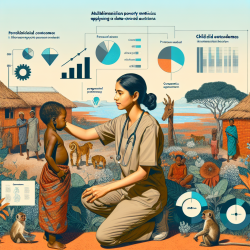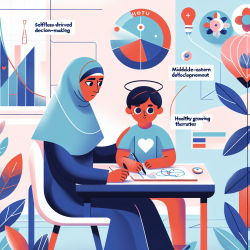Introduction
The intricate relationship between poverty and wildlife conservation has been a subject of extensive research, as highlighted in the study "A Nuanced Examination of Primate Capture and Consumption and Human Socio-Economic Well-Being in Kirindy Mitea National Park, Madagascar." This research underscores the importance of using multidimensional poverty metrics to understand the drivers of lemur hunting and consumption. As practitioners in speech-language pathology, we can draw parallels from this research to enhance our practice by adopting a more comprehensive approach to assessing and addressing poverty's impact on child outcomes.
Understanding Multidimensional Poverty
The study conducted in Madagascar utilized a composite poverty metric, the Multidimensional Poverty Index (MPI), which includes health, education, and living standards. This approach offers a more holistic view of poverty compared to traditional income-based measures. The findings revealed that nearly all households in the study were impoverished, yet no direct relationship was found between poverty and lemur hunting and consumption. This suggests that poverty's impact is complex and multifaceted, warranting a broader perspective in analysis.
Implications for Speech-Language Pathology
In speech-language pathology, understanding the socio-economic context of the children we serve is crucial for developing effective intervention strategies. By adopting a multidimensional approach to assess poverty, practitioners can gain a deeper insight into the barriers children face in their language development. Here are some practical steps to consider:
- Comprehensive Assessment: Incorporate measures that assess not only the child's linguistic abilities but also their health, educational opportunities, and living conditions.
- Holistic Intervention Planning: Design interventions that address multiple aspects of a child's environment, such as nutrition and access to educational resources, alongside language therapy.
- Collaborative Efforts: Work with other professionals, including educators and healthcare providers, to create a supportive network that addresses the diverse needs of children from impoverished backgrounds.
Encouraging Further Research
The findings from Madagascar highlight the need for further research to explore other potential drivers of behaviors such as lemur hunting. Similarly, in speech-language pathology, ongoing research is essential to uncover the complex interactions between socio-economic factors and language development. Practitioners are encouraged to engage in research that examines these relationships and to apply data-driven insights to improve outcomes for children.
Conclusion
By integrating multidimensional poverty metrics into our practice, we can better understand and address the challenges faced by children in impoverished communities. This approach not only aligns with the data-driven ethos of our field but also enhances our ability to create meaningful and lasting improvements in child outcomes.
To read the original research paper, please follow this link: A Nuanced Examination of Primate Capture and Consumption and Human Socio-Economic Well-Being in Kirindy Mitea National Park, Madagascar.










